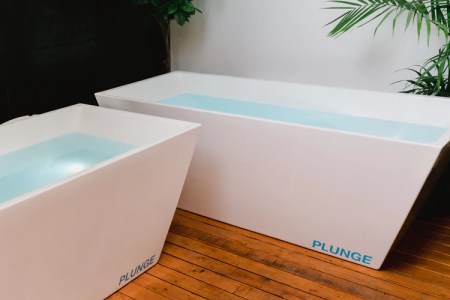The Curator independently decides what topics and products we feature. When you purchase an item through our links, we may earn a commission. Promotions and products are subject to availability and retailer terms.
Whether you’re an elite-level athlete or a weekend warrior, chances are you’ve encountered pulled muscles or stiff joints somewhere along the way. While an ice pack might be your first go-to, dunking in a cold lake or an ice-filled tub has become increasingly popular as the benefits of the ice bath has been praised by professional sports stars and regular gym goers alike.

The ice plunge, or cold water immersion, is purported to have all sorts of health benefits, from easing muscle soreness and improving sleep to better mental health. So what exactly do cold showers or jumping into a cold lake or ice bath (at least as low as 10 – 15 C) do to the body to help propel these changes?
“They all have one thing in common. They get your skin very cold, very quickly,” says Professor Stephen Cheung of the Department of Kinesiology at Brock University. Cheung runs the Environmental Ergonomics Lab at Brock and conducts research on extreme environments and how they impact physiology and performance.
“When your skin temperature drops very quickly, your sympathetic nervous system, the fight or flight system, goes into overdrive. You see an increase in heart rate, an increase in breathing, you may be panting — that is all your sympathetic nervous system.”
Reduced inflammation for serious athletes is another major benefit that has some science behind it, says Cheung. For example, if an athlete gets a large bruise during a rugby tournament and needs to get back onto the field for another game, dunking in an ice bath will reduce inflammation to the area, which will reduce swelling and soreness. He says it can also be helpful for a runner who’s just finished a marathon and wants to reduce the stiffness that happens for several days afterward.
And the body’s response to cold seems to last for some time, says Professor John Holash, who studies exercise and muscle physiology at the faculty of kinesiology’s Human Performance Lab at the University of Calgary. “That’s the most interesting thing. Cold exposure seems to have a really profound and lasting effect,” he noted, saying that cold therapy is one of the best ways for people to get in touch with their autonomic nervous system, the system of nerves that regulates the body’s involuntary functions including heartbeat or blood pressure.
“This is your autonomic nervous system at work,” Holash says. Stimulating this system means increased cardiac output and increased serotonin.
For some, that increased serotonin can provide relief from low moods, especially in the darker winter months.
Cheung says improved mood is one of the most commonly reported, and researched, benefits of cold plunge therapy.
“Especially if people are prone to some form of decrease in mood or mild depression in winter from lack of sun, this can be a way to kick-start it,” says Cheung.
There is a population of people who should not try cold plunge, however, warn the researchers. Those include people with high blood pressure, or cardiovascular issues, those with Raynaud’s disease or allergy to cold.
And, warns Cheung, always use a buddy system when you do cold plunge, because you don’t know how your body will react.
There are a few methods to ensure that you get a good experience, notes Holash. One is to develop your own breathing technique to help your body deal with the cold water. Cold water guru Wim Hof has many breathing techniques and instructional information, but it is based on a breathing ritual that is a big inhalation followed by a full exhalation, Holash says. This type of breathing can help your body “handle” the shock of the cold water a bit better.
He says the recommendation for those who want to engage regularly in the practice is about four times per week, and about four minutes of exposure at one time.
Both researchers say people don’t need to spend lots of money to get started in immersion therapy, saying you can try filling a tub with ice or starting in the shower by turning it to its coldest setting.
If you want to explore some at-home options, here are just a few:











Comments